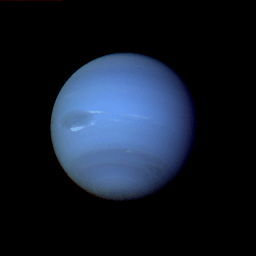
Neptune
Neptune is usually the eighth planet from the Sun and is the last
of the four Jovian planets, sometimes referred to as the outer
planets or gas giants. It was discovered because Uranus’
orbit was not following its predicted path, so scientists
inferred that there was another planet out in space pulling at it
(1). Neptune was discovered in 1846 and was named for the roman
god of the sea because of its blue-green color (1). From 1979 to
1999 it was actually the furthest planet from the Sun because of
Pluto’s strange orbit (3).
Neptune and Uranus are sometimes called the twin giants because
they are alike in so many ways (1). They both have about the same
size (Neptune is 48,600 km, Uranus is 50,800 km), mass, and
temperature (around -220º C), and also glow with the same
blue-green color (1). Also like Uranus, Neptune is covered by a
thick cloud cover of methane gas (1). Because Neptune is a lot
further from the Sun than Uranus is (it is about 4,486 million km
from the Sun), its year is significantly bigger than Uranus’
(one Neptune year equals 164.8 Earth years)(1). Neptune and
Uranus’ days, however, are fairly close to each other,
Neptune’s being 16 hours and Uranus’ being 16.5 hours
(1). Neptune’s atmosphere is made mostly of hydrogen and
helium, and its surface is probably an ocean of water and liquid
methane covering a rocky core (1). Because Neptune isn’t as
cold as it should be, being so far away from the Sun, it is
assumed that it has some sort of internal heat source (2).
Among things orbiting Neptune include at least eight moons, and
five rings made of dust particles that may have formed millions
of years ago when meteoroids crashed into Neptune’s moons
(1). Neptune’s largest moon, Triton, is the most interesting
of Neptune’s moons. It is covered with frozen methane and
has an atmosphere that resembles Saturn’s moon Titan. It is
unusual because it has retrograde rotation and it is gradually
moving closer to Neptune (3). Scientists believe this to be
because Triton was not an original moon, but an object captured
by Neptune’s gravitational pull (1). Scientists also
speculate that, since it is gradually getting closer to the
planet, it will one day, in about 10 to 100 million years,
collide with Neptune and form a vast ring system around Neptune
that will be as big or bigger than Saturn’s (3).
